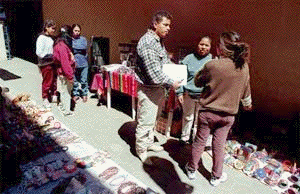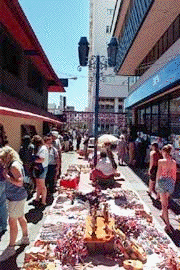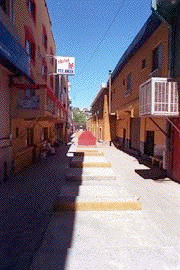Battling for dollars
Complicated alliances, rules govern who gets prime selling
spots in Nogales tourist district
Thursday, 6 April 2000
http://www.azstarnet.com/public/dnews/000406NogalesVendors.html
Photos by Jeffry Scott, The Arizona Daily Star

------------------------------------------------------------------------
Carlos Ramirez Flores, a Nogales inspector, talks with vendors
Antonia Ramirez Martinez and Sofia Ramirez, right, about their
selling spaces
------------------------------------------------------------------------

A repainted alleyway called Pasaje Morelos was Nogales' solution
for getting street vendors off its main sidewalks ... ------------------------
By Tim Steller
The Arizona Daily Star
NOGALES, Sonora - Behind each tourist's purchase here of a
wooden armadillo or a leather wallet lurks an unseen struggle
over turf.
An invisible hierarchy rules the downtown streets, and Indian
street vendors say they are being held at the bottom of it.
Over the past two years, the city government has pushed them
down, vendors said, through a downtown revitalization plan intended
to attract American tourists. Most of the plan has languished
for lack of funding, but the city succeeded in one aspect of the
effort.
They rousted mostly indigenous street vendors - twice -from
the preferred sidewalk sites where they used to spread their blankets.
From the tourist's perspective, the purpose was admirable:
clearing off the sidewalks to make them safer and less intimidating.
That way, American visitors - 230,000 of whom traveled to Nogales
in 1998 - could more comfortably pour in dollars, the lifeblood
of downtown's tourist sector.
But the indigenous vendors say that purpose is already being
defeated. Peddlers with political connections have replaced them
on some sidewalks. Plus, shopkeepers continue to block the main
tourist routes with stacks of blankets and other wares, and the
city government doesn't stop them.
The apparent discrimination grates on belt salesman Alfredo
Martinez, a Mazahua Indian who has lived in Nogales for 18 years.
"We are against the plan because if they're trying to
clear the streets, they should make it even, without distinctions
of race or color,'' Martinez said.
Martinez and other vendors, including shopkeepers, described
a complicated system of alliances, laws and customs that govern
the apparently disordered world of sidewalk vending in Nogales.
All share the objective of collecting tourist dollars, but no
one simply throws down a blanket and starts coaxing passing Americans.
Most vendors join one of several unions, which have varying
degrees of influence in City Hall. The union leaders and city
inspectors, in turn, hold power over sidewalk spaces and can unilaterally
move vendors out of their assigned spots.
Among Indian vendors there is also a division between the Mazahua
vendors, primarily from the state of Mexico, near Mexico City,
and the Mixtec vendors, from the southern state of Oaxaca. There
is an additional division among Indian vendors of the same ethnic
group - between recent arrivals and longtimers.
Most of them buy their products - from animal-shaped pottery
to knockoffs of brand-name sunglasses - on credit from vendors
in their home states or in the big Mexican cities. On the wholesalers'
return trip, they expect payment.
"Our life is a struggle,'' said baseball-cap vendor Pablo
Valencia Hernandez. "One has to abstain from many things."
Perhaps unintentionally, Mayor Wenceslao Cota Montoya made
the vendors' lives harder when he set the revitalization plan
in motion in early 1998. Cota said the plan would make Nogales
a more inviting destination and a more attractive gateway to the
rest of Mexico.
The $2 million plan included building an open-air tourist marketplace,
cleaning and painting hillside homes, and renovating downtown
facades. But promised federal funding never materialized, and
the local and federal administrations will be leaving office after
the July 2 election, with little of the plan accomplished.
The most visible improvement was the construction of the tourist
marketplace - called the tianguis turístico in Spanish
- which now stands empty on Calle Internacional, a symbol of the
plan's demise. The city built the two-block-long marketplace and
later forced street vendors to move there. But it couldn't keep
them there.
Antonia Ramirez Martinez spent three months under the red roof
of the open-air marketplace in 1998. She couldn't make a living
because so few tourists visited the street, which is off the beaten
path and retains a rough reputation.
 ------------------------------------------------------------------------
------------------------------------------------------------------------
Federico Ahuatzi says he and fellow shopkeepers "pay taxes,
pay rent, pay for electricity. (Street vendors) don't pay for
anything. It's unfair competition."
------------------------------------------------------------------------
So the 38-year-old Mazahua woman moved back to a piece of sidewalk
just south of the port of entry. But city and federal authorities
came down on her and the other vendors at the port of entry on
Jan. 15.
"They gave us 10 minutes to pick up all this stuff,''
Ramirez said, gesturing to her blanket topped with brightly painted
tortoises and other common trinkets.
They sent Ramirez and about 30 other vendors to a repainted
alleyway off Calle Campillo, the main tourist route toward downtown's
central street, Avenida Obregon. In the alleyway, called Pasaje
Morelos, each vendor has 52 inches of sidewalk space on which
to spread his or her blanket.
Terri Place, an Arizona State University graduate student in
anthropology, has interviewed the street vendors on Pasaje Morelos
for her master's thesis, and she points out that shopkeepers only
a few yards away also sell their products from the sidewalk.
"The shop owners have moved a lot of their inventory into
the street," Place said. "The walkway is just as congested
by what these shop owners are putting into the walkway as what
these women do.
"It's not what's crowding the space, but who.''
City officials say their effort isn't racially motivated but
is simply intent on imposing order on streets that tend toward
disorder. In Pasaje Morelos, for example, the vendors must occupy
the space and not be absent more than five times each month or
the city inspector will revoke their licenses.
Inspector Carlos Ramirez Flores emphasized that threat during
a visit to the alleyway Tuesday, drawing loud objections from
the Mazahua women who dominate the area.
It was that same city inspector who had seized their wares
during January's forced removal, Antonia Ramirez said.
But the inspectors aren't the only threat the street vendors
face. Almost all of them belong to a union, led by a vendor who
mediates with the city on issues such as licensure. The leader
also functions as a street boss who can move vendors at his leisure,
vendors said.
Asked what union she belonged to, vendor Marta Alvarado, a
Mixtec Indian from southern Mexico, said in broken Spanish that
she didn't know the group's name, but added, "The leader
is named Lucrecia.''
Many of the street vendors' unions belong to larger, government-controlled
federations. Some have more political pull than others, a fact
that becomes evident in the areas near the port of entry where
the Mazahua women were removed in January.
There, a new vendor, Crecencio Flores Rodriguez, said he belongs
to the Union of Street Vendors of the International Border, whose
members wear blue vests. That union's connections are clear in
a visit to the Mayor's Office, where a certificate from the union
hangs in his waiting room.
"They simply have pull,'' said Alfredo Martinez, the belt
salesman.
But shopkeepers complain that all the street vendors, including
the indigenous ones, have too much pull. Each city administration
promises to clean off the sidewalks, but the union leaders, who
belong to the governing political party, persuade the politicians
to hold off, said Federico Ahuatzi.
Ahuatzi rents a small space in the Centro Comercial Juarez,
where street vendors crowd his doorway and neighboring renters
also compete, selling the same blankets and ironwork that are
his staples. But it's the street vendors who bother him most.
"The tenants pay taxes, pay rent, pay for electricity.
(Street vendors) don't pay for anything,'' he said. "It's
unfair competition."
While Ahuatzi and other shopkeepers are quick to complain,
they are also resigned to the notion that things won't change
soon.
Poor migrants come from the rest of Mexico all the time, they
say, some even more impoverished than the street vendors.
"These things just don't end,'' said shop owner Arnoldo
Juarez. "It's called Mexico."


 ------------------------------------------------------------------------
------------------------------------------------------------------------